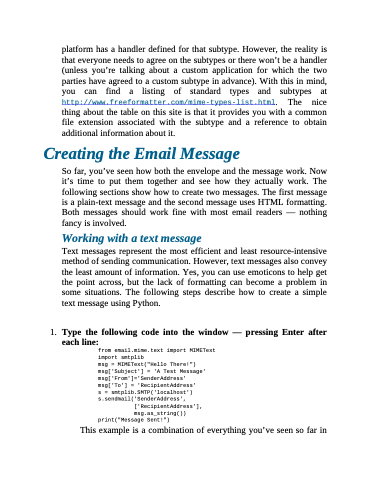Page 401 - Beginning Programming with Pyth - John Paul Mueller
P. 401
platform has a handler defined for that subtype. However, the reality is that everyone needs to agree on the subtypes or there won’t be a handler (unless you’re talking about a custom application for which the two parties have agreed to a custom subtype in advance). With this in mind, you can find a listing of standard types and subtypes at http://www.freeformatter.com/mime-types-list.html. The nice thing about the table on this site is that it provides you with a common file extension associated with the subtype and a reference to obtain additional information about it.
Creating the Email Message
So far, you’ve seen how both the envelope and the message work. Now it’s time to put them together and see how they actually work. The following sections show how to create two messages. The first message is a plain-text message and the second message uses HTML formatting. Both messages should work fine with most email readers — nothing fancy is involved.
Working with a text message
Text messages represent the most efficient and least resource-intensive method of sending communication. However, text messages also convey the least amount of information. Yes, you can use emoticons to help get the point across, but the lack of formatting can become a problem in some situations. The following steps describe how to create a simple text message using Python.
1. Type the following code into the window — pressing Enter after
each line:
from email.mime.text import MIMEText import smtplib
msg = MIMEText("Hello There!") msg['Subject'] = 'A Test Message' msg['From']='SenderAddress' msg['To'] = 'RecipientAddress'
s = smtplib.SMTP('localhost') s.sendmail('SenderAddress',
['RecipientAddress'],
msg.as_string()) print("Message Sent!")
This example is a combination of everything you’ve seen so far in


